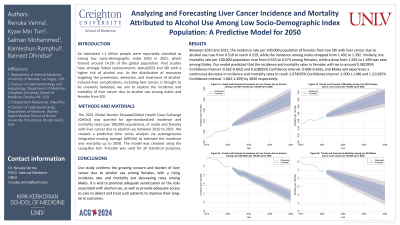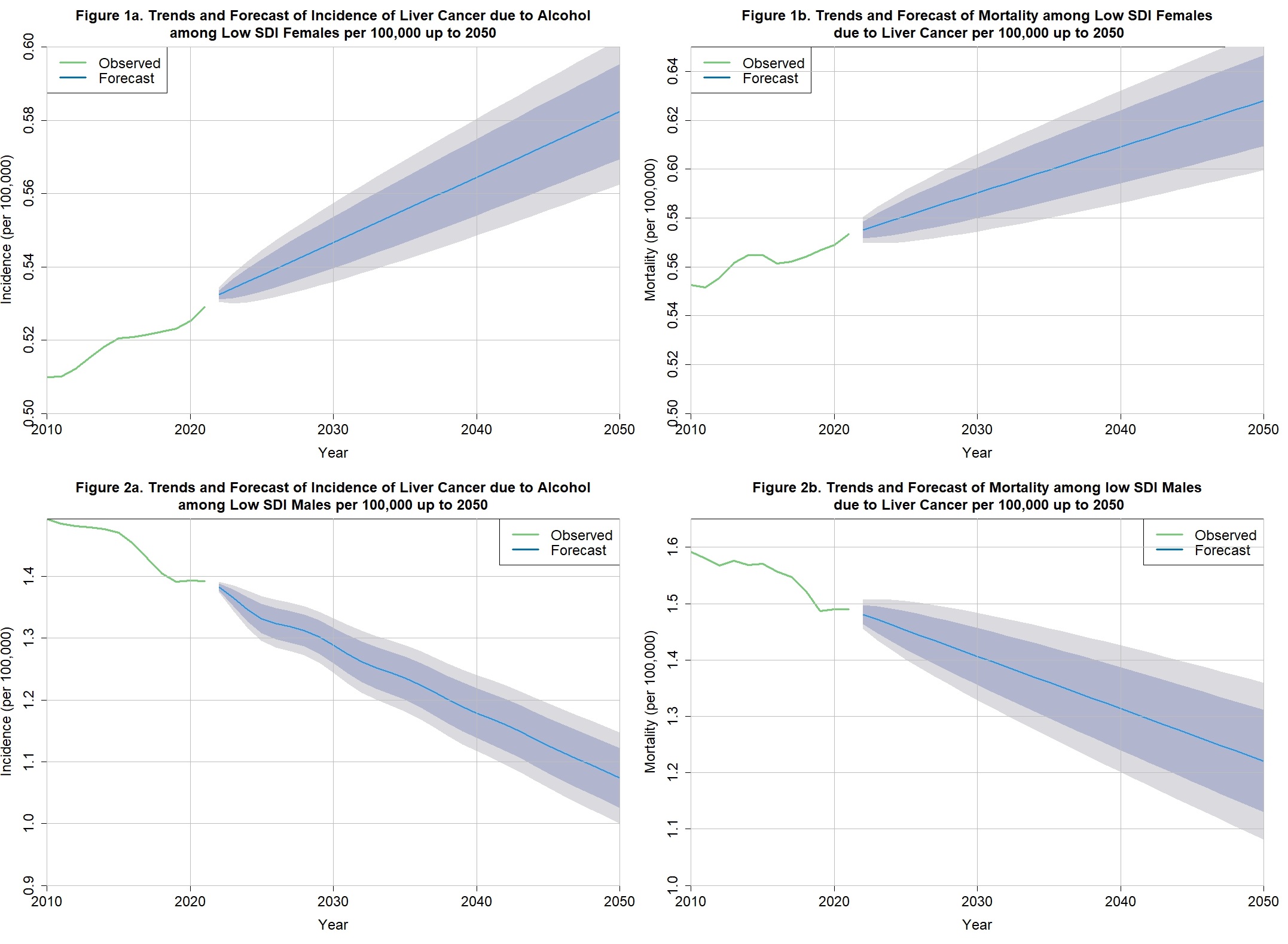Tuesday Poster Session
Category: Liver
P4672 - Analyzing and Forecasting Liver Cancer Incidence and Mortality Attributed to Alcohol Use Among Low Socio-Demographic Index Population: A Predictive Model for 2050
Tuesday, October 29, 2024
10:30 AM - 4:00 PM ET
Location: Exhibit Hall E

Has Audio
- RV
Renuka Verma, MD
University of Nevada
Las Vegas, NV
Presenting Author(s)
Renuka Verma, MD1, Kyaw Min Tun, DO2, Salman Mohammed, MS3, Kamleshun Ramphul, MD4, Banreet Dhindsa, MD5
1University of Nevada, Las Vegas, NV; 2Creighton University School of Medicine, Las Vegas, NV; 3Kirk Kerkorian School of Medicine at the University of Nevada, Las Vegas, NV; 4Independent Researcher, Triolet, Pamplemousses, Mauritius; 5NYU Grossman School of Medicine, New York, NY
Introduction: An estimated 1.1 billion people were reportedly classified as having low socio-demographic index (SDI) in 2021, which formed around 14.2% of the global population. Past studies have strongly linked socioeconomic status(SES) and SDI with a higher risk of alcohol use. As the distribution of resources targeting the prevention, detection, and treatment of alcohol-induced liver complications, including liver cancer, is thought to be unevenly balanced, we aim to explore the incidence and mortality of liver cancer due to alcohol use among males and females from SDI.
Methods: The 2021 Global Burden Disease(Global Health Data Exchange (GHDx)) was queried for age-standardized incidence and mortality rates (per 100,000 population), of males and females with liver cancer due to alcohol use between 2010 to 2021. We created a predictive time series analysis via autoregressive integrated moving average (ARIMA) to estimate the incidence and mortality up to 2050. The model was checked using the Ljung-Box test. R-studio was used for all statistical purposes.
Results: Between 2010 and 2021, the incidence rate per 100,000 population of females from low SDI with liver cancer due to alcohol use rose from 0.510 to reach 0.529, while the incidence among males dropped from 1.492 to 1.392. Similarly, the mortality rate per 100,000 population rose from 0.553 to 0.573 among Females, while a drop from 1.592 to 1.490 was seen among Males. Our model predicted that the incidence and mortality rates in Females will rise to around 0.582(95% Confidence Interval :0.562-0.602) and 0.628(95% Confidence Interval :0.600-0.656), and Males will experience a continuous decrease in incidence and mortality rates to reach 1.074(95% Confidence Interval :1.000-1.148) and 1.221(95% Confidence Internal: 1.082-1.359) by 2050 respectively.
Discussion: Our study confirms the growing concern and burden of liver cancer due to alcohol use among females, with a rising incidence rate and mortality but decreasing rates among Males. It is vital to promote adequate sensitization on the risks associated with alcohol use, as well as provide adequate access to care to detect and treat such patients to improve their long-term outcomes.

Disclosures:
Renuka Verma, MD1, Kyaw Min Tun, DO2, Salman Mohammed, MS3, Kamleshun Ramphul, MD4, Banreet Dhindsa, MD5. P4672 - Analyzing and Forecasting Liver Cancer Incidence and Mortality Attributed to Alcohol Use Among Low Socio-Demographic Index Population: A Predictive Model for 2050, ACG 2024 Annual Scientific Meeting Abstracts. Philadelphia, PA: American College of Gastroenterology.
1University of Nevada, Las Vegas, NV; 2Creighton University School of Medicine, Las Vegas, NV; 3Kirk Kerkorian School of Medicine at the University of Nevada, Las Vegas, NV; 4Independent Researcher, Triolet, Pamplemousses, Mauritius; 5NYU Grossman School of Medicine, New York, NY
Introduction: An estimated 1.1 billion people were reportedly classified as having low socio-demographic index (SDI) in 2021, which formed around 14.2% of the global population. Past studies have strongly linked socioeconomic status(SES) and SDI with a higher risk of alcohol use. As the distribution of resources targeting the prevention, detection, and treatment of alcohol-induced liver complications, including liver cancer, is thought to be unevenly balanced, we aim to explore the incidence and mortality of liver cancer due to alcohol use among males and females from SDI.
Methods: The 2021 Global Burden Disease(Global Health Data Exchange (GHDx)) was queried for age-standardized incidence and mortality rates (per 100,000 population), of males and females with liver cancer due to alcohol use between 2010 to 2021. We created a predictive time series analysis via autoregressive integrated moving average (ARIMA) to estimate the incidence and mortality up to 2050. The model was checked using the Ljung-Box test. R-studio was used for all statistical purposes.
Results: Between 2010 and 2021, the incidence rate per 100,000 population of females from low SDI with liver cancer due to alcohol use rose from 0.510 to reach 0.529, while the incidence among males dropped from 1.492 to 1.392. Similarly, the mortality rate per 100,000 population rose from 0.553 to 0.573 among Females, while a drop from 1.592 to 1.490 was seen among Males. Our model predicted that the incidence and mortality rates in Females will rise to around 0.582(95% Confidence Interval :0.562-0.602) and 0.628(95% Confidence Interval :0.600-0.656), and Males will experience a continuous decrease in incidence and mortality rates to reach 1.074(95% Confidence Interval :1.000-1.148) and 1.221(95% Confidence Internal: 1.082-1.359) by 2050 respectively.
Discussion: Our study confirms the growing concern and burden of liver cancer due to alcohol use among females, with a rising incidence rate and mortality but decreasing rates among Males. It is vital to promote adequate sensitization on the risks associated with alcohol use, as well as provide adequate access to care to detect and treat such patients to improve their long-term outcomes.

Figure: Trends and forecast in incidence and mortality of low SDI males and females for liver cancer due to alcohol use
Disclosures:
Renuka Verma indicated no relevant financial relationships.
Kyaw Min Tun indicated no relevant financial relationships.
Salman Mohammed indicated no relevant financial relationships.
Kamleshun Ramphul indicated no relevant financial relationships.
Banreet Dhindsa indicated no relevant financial relationships.
Renuka Verma, MD1, Kyaw Min Tun, DO2, Salman Mohammed, MS3, Kamleshun Ramphul, MD4, Banreet Dhindsa, MD5. P4672 - Analyzing and Forecasting Liver Cancer Incidence and Mortality Attributed to Alcohol Use Among Low Socio-Demographic Index Population: A Predictive Model for 2050, ACG 2024 Annual Scientific Meeting Abstracts. Philadelphia, PA: American College of Gastroenterology.
